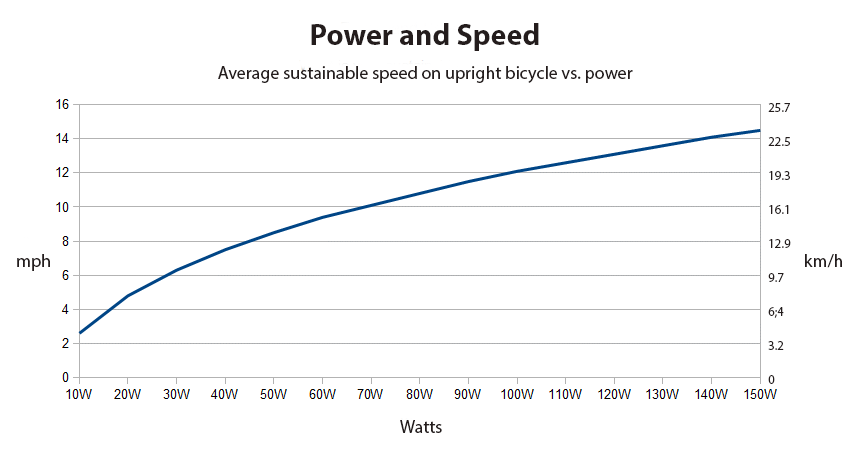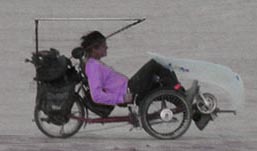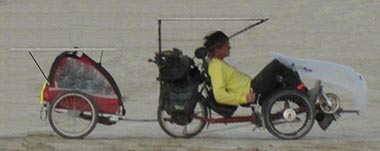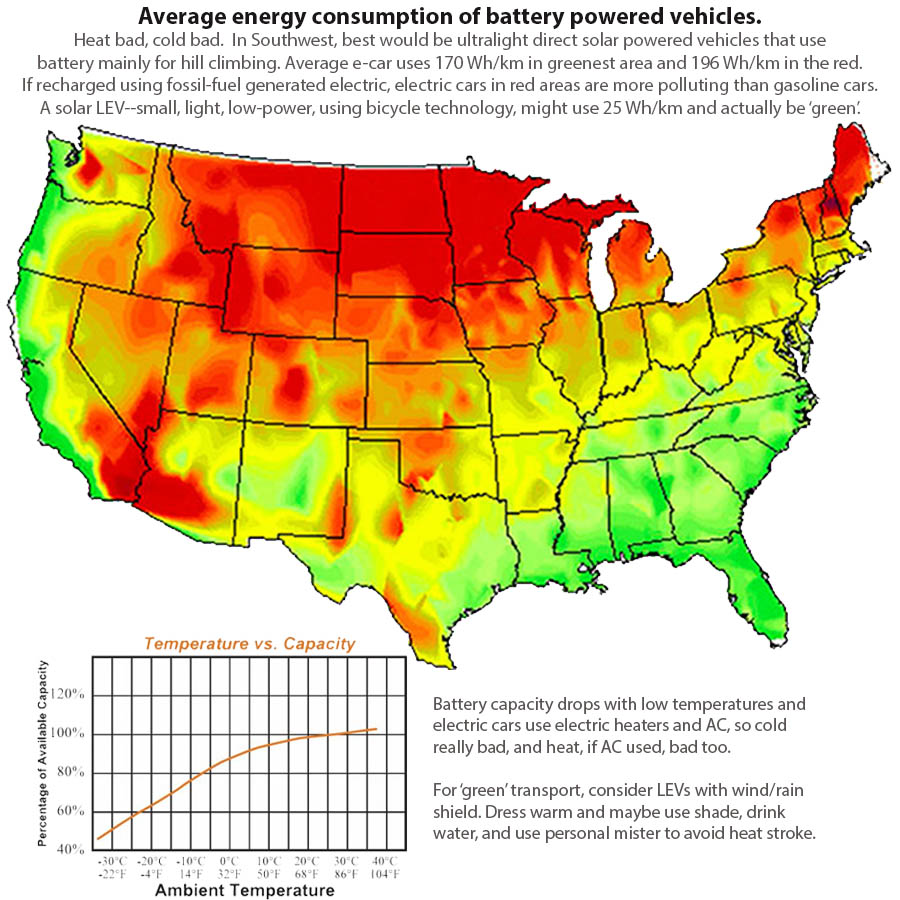Solar E-trike Touring
The options depend on human power
Touring without electric-power assist is possible for some, but touring involves carrying stuff and is rather like riding a tandem where you are the only one pedaling (really hard). To go 50 miles may require pedaling 5 or 6 hours of pedaling. Few are up to it; few could pedal a bike, with only a water bottle as extra weight, 50 miles a day, day after day, let alone a laden touring bike, so most need to consider e-assist. To tour free from the plug (to recharge batteries), solar panels enable unfettered exploration.
In the USA 85% of bicycle trips involve a trip of less than 5 km (3 miles) and very few Americans ever ride a bicycle after the age of 12. Even in the Netherlands, the most bicycle enthusiastic country in the Western world, 77 % of bike trips are less than 5 km. Only 1% of Dutch bicycle trips are more than 15 km (9 miles). It is unlikely that 1% of a population would tour by bicycle even if they could. The number willing to tour by e-trike, when cars become few, could well be an order of magnitude higher as even the elderly could if they would.
Touring by solar e-cycle without pulling a trailer would require minimum gear, such as an experienced backpacker would carry, or limiting travel to developed areas and using a credit card to eat out and avoid camping out. Someone requiring minimum e-assist could tour using an e-bicycle with up to maybe 200 watts of solar panels (that may deliver up to 120W of power to the wheel), but if more power is needed, a recumbent trike could carry 400 watts of panels overhead and, if needed, pull a trailer carrying another 400 - 600 watts of panels plus food, water, and gear. So using a trike for touring, with or without a trailer, will be assumed.
Using solar electric for power instead of human power, however, comes at a high cost, which some measure in terms of money, but the real cost is in energy embodied (emergy) in the technology: motor, battery, electronics, and solar panels. In a post-car future (average car consumes up to 165,000 watts which, in a low energy future, accounts for the 'post' in 'post-car') few would be able to have a solar e-trike because there would not be enough energy to make more than a few no matter how much money was printed to pay for one. Perhaps only those who had saved up over 30 to 40 years to deserve one by walking and riding a bicycle when they were able to would have such an extravagant form of individual transportation. At best, imagine a future where solar e-trikes are rationed on the basis of need. Those who actually needed one may only get a lottery ticket entitling them to a chance to get one. A world where billions ride e-bikes would not be sustainable anymore than are the 1 billion cars currently plying the globe.
There is no evidence that solar power can support a solar civilization not subsidized by fossil fuel. Current solar panels are made by dirty (and cheap) coal in China. The only solar panels in the future may have to be made using hydroelectric, tidal, or geothermal in those few places having such renewable energy sources. If so, solar power will be a premium power source. Solar may be the only electric power for personal use in most areas. It may be that solar power for personal use will be limited to 5 watts when the sun shines. Techno optimists may think everyone, in a post-fossil fuel world, could have at least 50 watts and batteries to charge. Saying that 500 watts are not enough to meet your transportation needs will sound like claiming that a personal jet plane is a necessity.
A person who can sustain 225 watts human power for an hour should be able to sustain 150 watts for five hours. Those who can sustain 150 watts for an hour may need minimum assist to tour as they can't expect to sustain much more than 100 watts for five hours. So if panels provide up to 120 watts, that allows for 50 watts added to the human power and 70 watts for charging the battery that will be drawn on to climb hills or power into headwinds. On the other end of the spectrum are those who can pedal little, or not at all, who would depend, at times, entirely on solar to power the cycle and charge the battery.
Many people (average people: as they who walk the aisles of Wal-Mart, not average bicyclists who are of well above average fitness) cannot pedal for five hours, let alone sustain much more than 30 watts when they do pedal, so a minimum touring rig for the unfit would be a trike carrying 400 watts (maybe up to 240W actual) of solar panels and lightly laden. If pulling a moderately loaded trailer, the trike could carry 200 watts, the trailer 200 to 400 watts (providing up to 360W total), and to climb hills the trailer should have its own motor and batteries to help push the trike. More power needed means more panels, more batteries, more weight, and so more power than a human only powered cycle needs. If total weight is on the heavy side, 800 watts of panels (about 480W actual) would be needed. Hills would drain the batteries and enough solar power would be needed to power the trike on the flats and recharge the batteries.
For those used to driving an average "under-powered" car (average = 165,000 watts, so half of car consumers willingly pay more for more power and most of the others wish they could afford a more powerful car—up to 900,000+W), a mere 450 watts of power may seem pathetic, but it is more than most Tour de France cyclists can maintain. It is also more than ten times what average aisle walkers can average, so the power provided by 100W to 800W of nominal panels is "power enough."
Let Us Count the Watts
To tour under human only power, you should be a B+ or A class bicyclist able to sustain 250W for a hour. If you don't know your class, you may be very fit but you're likely not very fit enough. To know what you need by way of assist, you need to know approximately how many watts you can sustain and for how long. There are exercise bikes that measure your wattage. Pedal one for an hour and see what your average is. Otherwise, ride a common upright bike for an hour on mostly flat ground and see what your average speed is. Google Maps allows you to map a route and specify that you are a bicyclist. Google seems to assume you are a C class rider good for 90 - 95 watts continuous. Ride the route and see if you are faster or slower than Google estimates the trip time. Your speed is mostly a function of how much power you output. Knowing your average speed, consult the following chart to get your wattage. Knowing your wattage, you can estimate how much assisted power you will need to tour, adjusted for your weight and the weight of stuff carried. The cost of more weight is more power.

A recumbent cycle would be a bit faster due to less drag, but a heavy touring cycle will be slower, so averaging 10 mph to 12 mph would be reasonable as it is faster than sub-athletic humans could maintain under human power only while touring.
The 200W Helper
 If you can output
150 watts for an hour, or 100W for five hours, a 200W solar assist trike
should be power enough. The panels need to make up for any deficit in
human power you experience and have some left over to recharge the
battery that will be used primarily for hill climbing.
If you can output
150 watts for an hour, or 100W for five hours, a 200W solar assist trike
should be power enough. The panels need to make up for any deficit in
human power you experience and have some left over to recharge the
battery that will be used primarily for hill climbing.
The system would consist of two 100W panels, one Genasun solar charge controller, one 48V 13Ah lithium battery, and a 500W direct-drive hub motor. No trailer would be used, so load would be on the light weight side.
This configuration also offers power enough for most humans for commuting or just as a runabout, to go out from a home base, around about, and back. For touring, the sub-athletic could add a trailer with its own power, and detach the trailer at a campsite and use the Helper trike to explore the surrounding area.
The 400W Tourer
 If pulling a trailer
and your human power output is around 100 watts for one hour, then 400W
solar assist should be power enough. Same rig as above, but add a
trailer carrying its own 200W array. With only one motor, touring in
mountainous areas may overheat the motor requiring stops to let it cool
down. direct-drive motors become increasing less efficient on slopes
over 3% as speed goes down. On long slopes over 5%, overheating may
become an issue depending on weight. If not planning to travel light,
the trailer should have it's own motor and battery, making it a pusher
trailer. The trailer motor would only be used for hill climbing and so
should be a geared hub motor (which makes noise but will not overheat)
that will provide power for climbing more efficiently than a
direct-drive hub motor. One 500W geared hub motor on the trailer would
be enough. As what goes up comes down, the direct-drive motor provides
regenerative braking going downhill and braking is of critical
importance, which geared hub motors cannot do, so having both is a
versatile choice.
If pulling a trailer
and your human power output is around 100 watts for one hour, then 400W
solar assist should be power enough. Same rig as above, but add a
trailer carrying its own 200W array. With only one motor, touring in
mountainous areas may overheat the motor requiring stops to let it cool
down. direct-drive motors become increasing less efficient on slopes
over 3% as speed goes down. On long slopes over 5%, overheating may
become an issue depending on weight. If not planning to travel light,
the trailer should have it's own motor and battery, making it a pusher
trailer. The trailer motor would only be used for hill climbing and so
should be a geared hub motor (which makes noise but will not overheat)
that will provide power for climbing more efficiently than a
direct-drive hub motor. One 500W geared hub motor on the trailer would
be enough. As what goes up comes down, the direct-drive motor provides
regenerative braking going downhill and braking is of critical
importance, which geared hub motors cannot do, so having both is a
versatile choice.
The system would consist of four 100W panels, two Genasun solar charge controllers, two 48V 13Ah lithium batteries, and a 500W direct-drive hub motor in the trike and, optionally, a 500W geared hub motor in the trailer.
The 600W Explorer
 If your
sustainable human power is in the 30W to 90W range and pedaling for five
hours is not likely, you'll need more power as at times the system will
have to supply all needed power. This system is the same as the 400W
system, but with more panels, batteries, and two geared hub motors in
the trailer.
If your
sustainable human power is in the 30W to 90W range and pedaling for five
hours is not likely, you'll need more power as at times the system will
have to supply all needed power. This system is the same as the 400W
system, but with more panels, batteries, and two geared hub motors in
the trailer.
The system would consist of six 100W panels, three Genasun solar charge controllers, three 48V 13Ah lithium batteries, a 500W direct-drive hub motor in the trike, and two 500W geared hub motors in the trailer.
The 800W Trekker
 If your
sustainable human power is in the 20W to 40W range, and you won't be
traveling light, and pedaling for more than two hours is unlikely, then
you'll need more power as the system will basically have to supply
almost all needed power. This system is the same as the 600W system but
with more panels, and batteries.
If your
sustainable human power is in the 20W to 40W range, and you won't be
traveling light, and pedaling for more than two hours is unlikely, then
you'll need more power as the system will basically have to supply
almost all needed power. This system is the same as the 600W system but
with more panels, and batteries.
The system would consist of eight 100W panels—400W on trike and 400W on trailer, four Genasun solar charge controllers, four 48V 13Ah - 15Ah lithium batteries, two on trike and two on trailer, a 500W direct-drive hub motor in the trike, and two 500W geared hub motors in the trailer.
The 1000W Winnetriko
 If your
human power is less than marginal and you plan to tour on the grand
side, perhaps towing a boat to better explore bodies of water, you'll
need to max out on power. Touring without a boat assumes you can cross
rivers by bridge or ferry. As infrastructure deteriorates, this may be
too limiting. Same system as 200W or 400W on trike, but the trailer
would carry three 200W arrays (almost 11 feet of panels) which would
cover a 12.5 foot kayak.
If your
human power is less than marginal and you plan to tour on the grand
side, perhaps towing a boat to better explore bodies of water, you'll
need to max out on power. Touring without a boat assumes you can cross
rivers by bridge or ferry. As infrastructure deteriorates, this may be
too limiting. Same system as 200W or 400W on trike, but the trailer
would carry three 200W arrays (almost 11 feet of panels) which would
cover a 12.5 foot kayak.
Since you're going extreme, use four 20Ah batteries instead of 13Ah or 15Ah ones as you may need them if all three 500W motors have to be taken to full throttle when climbing steep hills. The Winnetriko option may not be as insanely extravagant as it may seem if you're touring indefinitely and you have everything you own with you that enables you to be functional as the months and years go by. Being a solar nomad (a Solmad) may be just the thing at some period in one's life. Most have or can aspire to have several lives to live, like Thoreau's life of two years and two months at Walden Pond. If exploring continents on an extended tour, having a 50 pound kayak to explore the many waterways (there are over 120 in Arizona, and many more elsewhere, not to mention seas and oceans) may well be considered worth hauling around. Having a trike that could fly would be nice, but one that could float on a boat is actually doable and will cost a lot, but a lot less than a $430K Winnebago. The Winnetriko should be compared to a Winnebago towing a high-speed motor boat. The rig and boat, with all the stuff that would fill the Winnebago could easily total a half million. The Winnetriko costs less and doesn't make immense fuel sucking sounds. When not touring, a thousand watts of solar panels could power a tiny house, so a Winnetriko is extreme, but not obscenely so.
For those with low average or better human power, the trike could carry 200W of solar and be used as a "Helper" system when the trailer was left in camp. This would be the 800W Winnetriko option.
The Mid-drive Option
If touring without a trailer, a direct-drive motor will wimp out on steep slopes (7-15+%) and if a geared hub motor in the front wheel is not an option (most trikes), then a mid-drive for occasional use will be needed. The premium system is the Ecospeed, but I'd only use a mid-drive in addition to having a direct-drive system for use most of the time. Since I'd use a mid-drive or geared hub motor only on 5+% slopes (more efficient than direct-drive), I'd want a direct-drive for the quiet and for regenerative braking on the downslope. If going up extreme slopes is a need, surviving going down them by moderating speed is equally important. With a touring load and extreme downslopes, I wouldn't trust bicycle brakes to work for long without regen assist. Since I'd rarely use a mid-drive system, and cost is a consideration, I'd consider a cheaper, less premium offering than the Ecospeed, something like a Bafang mid-drive.
Using a trailer, the extra motor/motors/batteries could go on the detachable pusher trailer, keeping the Helper trike free from the extra weight of an unneeded, when not heavily loaded, mid-drive system. A mid-drive overstresses the human power drivetrain system, making it less reliable. A cheap Bafang compromises the human power system by having only one chainring. So if touring without a trailer, Ecospeed would be the better choice unless little or no human power is available, in which case having lots of human power gears is not critical.
Life When Not on the Road
When not rolling, a base camp with 200 to 1000 watts of solar could
do more than power your laptop. When not touring, solar arrays could
power a small (Tiny?) house. To not abuse your lithium batteries by deep
discharge, an off-grid home might use a lead-acid battery bank, but
otherwise light-weight solar panels can always be put to good use.
Investing in solar panels has an energy payoff whether rolling or not.
